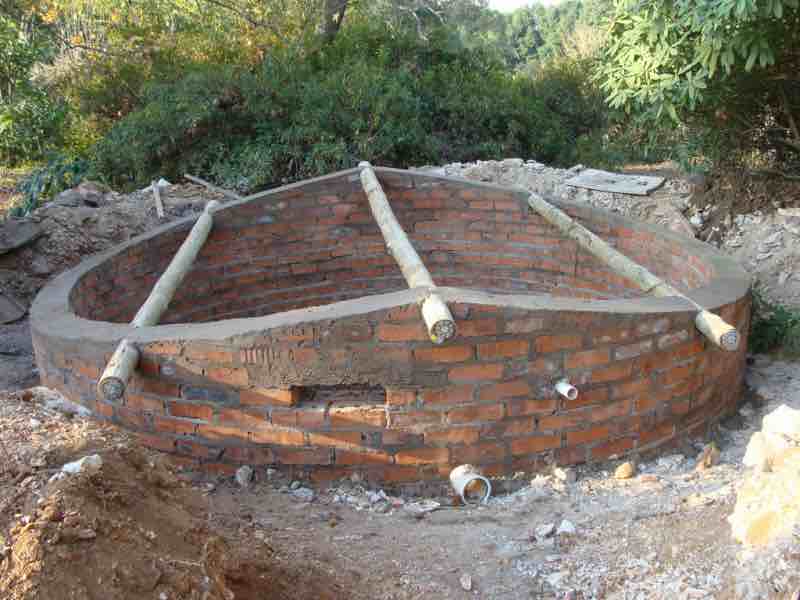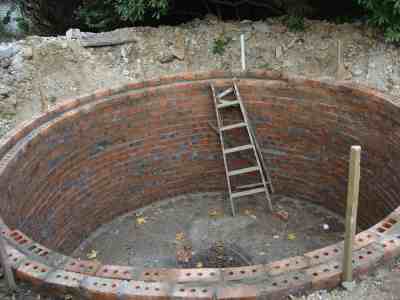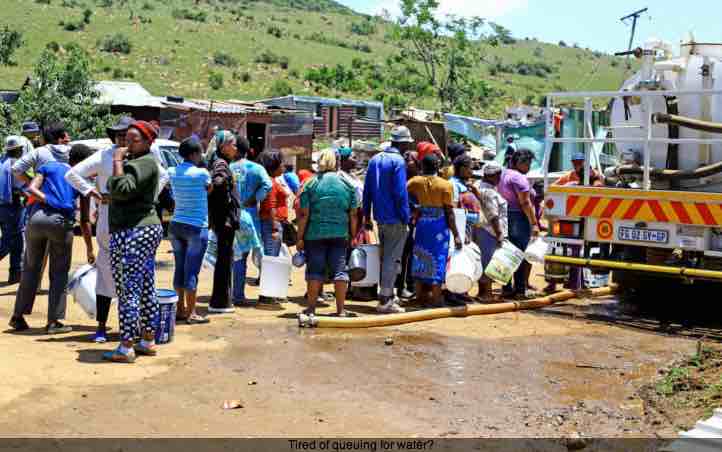- Bernard Preston homepage
- Harvesting Rainwater
- Community-built Underground Reservoirs
Community-built underground reservoirs
Community-built underground reservoirs can store harvested rainwater very effectively; it remains ice cold and although the official position is that the harvest from the heavenlies is not potable, our experience is that it remains pristine.
There are some provisos though. Primarily the gutters, the sump and the reservoir itself must be cleaned thoroughly annually.

A caretaker for the reservoir
The reservoir must be secured and should not be open to the general public; children and animals can drown. A responsible person appointed by the community should care for the maintenance and apportion out the water.
 Building these reservoirs provides work for the unemployed
Building these reservoirs provides work for the unemployedThe cost of an underground reservoir

Half the cost of the reservoir is roughly for materials and the rest for labour.
The base is made of reinforced concrete onto which a double-brick wall is built; and then plastered. Heavy gauge galvanised wire helps to secure the circular structure.
Treated poles covered with IBR sheeting complete the domed roof.
The estimated cost of a 40kL underground reservoir is about R50,000 in 2025. Fibreglassing whilst recommended to prevent all leaks is expensive.
For a wealthier community the construction workers would be paid. In a poorer society with high unemployment, an arrangement can be made that the builders would be recompensed with water and vegetables from the food garden. It becomes a project based on faith and trust for the greater good; much to be gained with nothing more potentially lost than the sweat off the crafter's brow.

The 4 phases of building
- The hole can be dug by hand by 4 strong men in less than a week depending on the structure of the earth. Shale, large rocks and other obstacles may be encountered.
- The slab, double wall and plastering can be built in another week.
- The roof can be erected in a couple days.
- Trenches have to be dug to bring sewerage 110ug conduit from the gutters and downpipes to the reservoir.
- A skilled supervisor cum engineer, competent bricklayers and skilled plasterers are essential.
 Most brick reservoirs leak unless fibreglassed
Most brick reservoirs leak unless fibreglassedThe community has to buy into this project

Most South Africans have become accustomed to spending long hours waiting and queuing for water of uncertain quality. Community-built underground reservoirs would solve many of their troubles.
For a community that can clearly see the benefits of clean water for their homes in the immediate area, a large vegetable garden to supply their creche and local school children with bellies filled with healthy food, the benefits are enormous; these people have endured severe shortages.
During the rainy season large amounts of free, pristine water would be available to the community; during the dry season most would be retained for the vegetable gardens and the creche.
Solar-powered electric pumps are an option.
Community-built underground reservoirs
Community-built underground reservoirs can store harvested rainwater; to supply homes and gardens dependent on irrigation in the dry season.
When browsing use right click and "Open Link in New Tab" or you may get a bad gateway signal.
Newsletter
Our newsletter is entitled "create a cyan zone" at your home, preserving both yourself and Mother Earth for future generations; and the family too, of course. We promise not to spam you with daily emails promoting various products. You may get an occasional nudge to buy one of my books.
Here are the back issues.
- Lifestyle and ideal body weight
- What are ultra-processed foods?
- Investing in long-term health
- Diseases from plastic exposure
- Intensive lifestyle management for obesity has limited value
- A world largely devoid of Parkinson's Disease
- The impact of friendly bacteria in the tum on the prevention of cancer
- There's a hole in the bucket
- Everyone is talking about weight loss drugs
- Pull the sweet tooth
- If you suffer from heartburn plant a susu
- Refined maize meal and stunting
- Should agriculture and industry get priority for water and electricity?
- Nature is calling
- Mill your own flour
- Bake your own sourdough bread
- Microplastics from our water
- Alternative types of water storage
- Wear your clothes out
- Comfort foods
- Create a bee-friendly environment
- Go to bed slightly hungry
- Keep bees
- Blue zone folk are religious
- Reduce plastic waste
- Family is important
- What can go in compost?
- Grow broad beans for longevity
- Harvest and store sunshine
- Blue zone exercise
- Harvest and store your rainwater
- Create a cyan zone at your home
Did you find this page interesting? How about forwarding it to a friendly book or food junkie? Better still, a social media tick would help.
- Bernard Preston homepage
- Harvesting Rainwater
- Community-built Underground Reservoirs
Address:
56 Groenekloof Rd,
Hilton, KZN
South Africa
Website:
https://www.bernard-preston.com